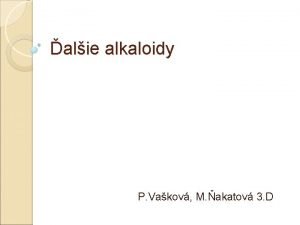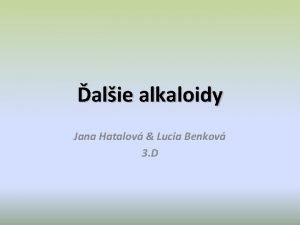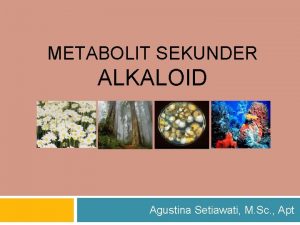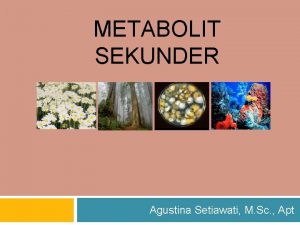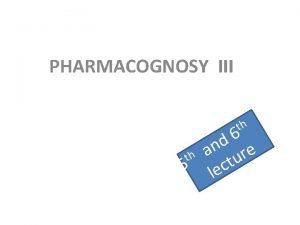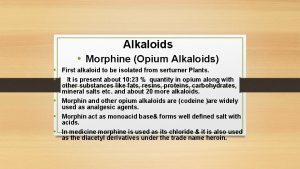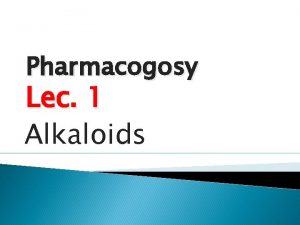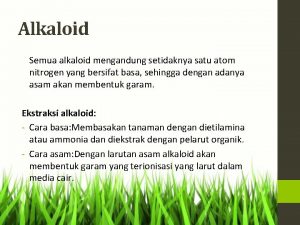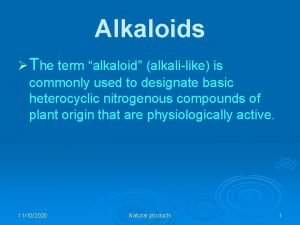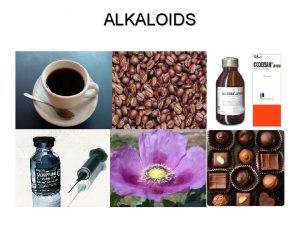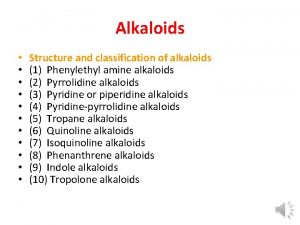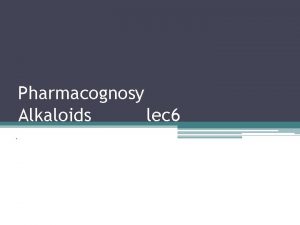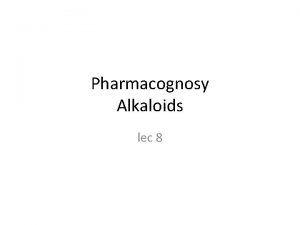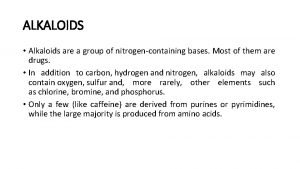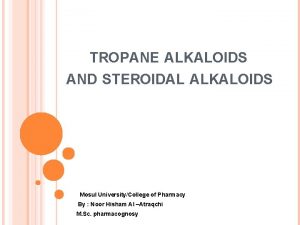ALKALOIDS What is an Alkaloid Alkaloids are a


















- Slides: 18

ALKALOIDS

What is an Alkaloid? � � � Alkaloids are a class of naturally occurring organic compounds that mostly contain basic nitrogen atoms. This group also includes some related compounds with neutral and even weakly acidic properties. Some synthetic compounds of similar structure may also be termed alkaloids. In addition to carbon, hydrogen and nitrogen, alkaloids may also contain oxygen, sulfur and, more rarely, other elements such as chlorine, bromine, and phosphorus.

Classifications � � Compared with most other classes of natural compounds, alkaloids are characterized by a great structural diversity. There is no uniform classification. More recent classifications are based on similarity of the carbon skeleton (e. g. , indole-, isoquinoline-, and pyridine-like) or biochemical precursor (ornithine, lysine, tyrosine, tryptophan, etc. ).

� However, they require compromises in borderline cases; for example, nicotine contains a pyridine fragment from nicotinamide and a pyrrolidine part from ornithine and therefore can be assigned to both classes.

They are classified as follows: � True alkaloids � Protoalkaloids � Polyamine alkaloids � Peptide and cyclopeptide alkaloids. � Pseudoalkaloids

Properties � Most alkaloids contain oxygen in their molecular structure; those compounds are usually colorless crystals at ambient conditions. Oxygen-free alkaloids, such as nicotine or coniine, are typically volatile, colorless, oily liquids. Some alkaloids are colored, like berberine (yellow) and sanguinarine (orange).

� Most alkaloids are weak bases, but some, such as theobromine and theophylline, are amphoteric. Many alkaloids dissolve poorly in water but readily dissolve in organic solvents, such as diethyl ether, chloroform or 1, 2 dichloroethane. Caffeine, [162] cocaine, [163] codeine[16 4] and nicotine[ are slightly soluble in water (with a solubility of ≥ 1 g/L), whereas others, including morphine and yohimbineare very slightly water-soluble (0. 1– 1 g/L). Alkaloids and acids form salts of various strengths.

� � These salts are usually freely soluble in water and ethanol and poorly soluble in most organic solvents. Exceptions include scopolamine hydrobromide, which is soluble in organic solvents, and the water-soluble quinine sulfate. Most alkaloids have a bitter taste or are poisonous when ingested. Alkaloid production in plants appeared to have evolved in response to feeding by herbivorous animals; however, some animals have evolved the ability to detoxify alkaloids.

� Some alkaloids can produce developmental defects in the offspring of animals that consume but cannot detoxify the alkaloids. One example is the alkaloid cyclopamine, produced in the leaves of corn lily. During the 1950 s, up to 25% of lambs born by sheep that had grazed on corn lily had serious facial deformations. These ranged from deformed jaws to cyclopia (see picture). After decades of research, in the 1980 s, the compound responsible for these deformities was identified as the alkaloid 11 deoxyjervine, later renamed to cyclopamine.

Biosynthesis � � Biological precursors of most alkaloids are amino acids, such as ornithine, lysine, phenylalanine, tyrosine, tryptop han, histidine, aspartic acid, and anthranilic acid. Nicotinic acid can be synthesized from tryptophan or aspartic acid. Ways of alkaloid biosynthesis are too numerous and cannot be easily classified. However, there a few typical reactions involved in the biosynthesis of various classes of alkaloids, including synthesis of Schiff bases and Mannich reaction.

Biological role � The role of alkaloids for living organisms that produce them is still unclear. It was initially assumed that the alkaloids are the final products of nitrogen metabolism in plants, as urea in mammals. It was later shown that alkaloid concentration varies over time, and this hypothesis was refuted. A number of ants are suggested to also produce alkaloids as venom components, however the exact biosynthesis pathways have not been empirically demonstrated.

� � Most of the known functions of alkaloids are related to protection. For example, aporphine alkaloid liriodenine produced by the tulip tree protects it from parasitic mushrooms. In addition, the presence of alkaloids in the plant prevents insects and chordate animals from eating it. However, some animals are adapted to alkaloids and even use them in their own metabolism. Such alkaloidrelated substances as serotonin, dopamine and histamine are important neurotransmitters in animals. Alkaloids are also known to regulate plant growth.

� One example of an organism that uses alkaloids for protection is the Utetheisa ornatrix, more commonly known as the ornate moth. Pyrrolizidine alkaloids render these larvae and adult moths unpalatable to many of their natural enemies like coccinelid beetles, green lacewings, insectivorous hemiptera and insectivorous bats. Another example of alkaloids being utilized occurs in the poison hemlock moth (Agonopterix alstroemeriana).

� This moth feeds on its highly toxic and alkaloid-rich host plant poison hemlock (Conium maculatum) during its larval stage. A. asltroemeriana may benefit twofold from the toxicity of the naturallyoccurring alkaloids, both through the unpalatability of the species to predators and through the ability of A. alstroemeriana to recognize Conium maculatum as the correct location for oviposition. A fire ant venom alkaloid known as solenopsin has been demonstrated to protect queens of invasive fire ants during the foundation of new nests, thus playing a central role in the spread of this pest ant species around the world.

Applications � � � In medicine Medical use of alkaloid-containing plants has a long history, and, thus, when the first alkaloids were isolated in the 19 th century, they immediately found application in clinical practice. Many alkaloids are still used in medicine, usually in the form of salts widely used. Many synthetic and semisynthetic drugs are structural modifications of the alkaloids, which were designed to enhance or change the primary effect of the drug and reduce unwanted side-effects. For example, naloxone, an opioid receptor antagonist, is a derivative of thebaine that is present in opium.

In agriculture � Prior to the development of a wide range of relatively low-toxic synthetic pesticides, some alkaloids, such as salts of nicotine and anabasine, were used as insecticides. Their use was limited by their high toxicity to humans.

Use as psychoactive drugs � � Preparations of plants containing alkaloids and their extracts, and later pure alkaloids, have long been used as psychoactive substances. Cocaine, caffeine, and cathinone are stimulants of the central nervous system. Mescaline and many indole alkaloids (such as psilocybin, dimethyltryptamine and ibogaine) have hallucinogenic effect. Morphine and codeine are strong narcotic pain killers.

� � � There alkaloids that do not have strong psychoactive effect themselves, but are precursors for semi-synthetic psychoactive drugs. For example, ephedrine and pseudoephedrine are used to produce methcathinone and methamphetamine. Thebaine is used in the synthesis of many painkillers such as oxycodone.
 Insidan region jh
Insidan region jh Alkaloid caju
Alkaloid caju Dorivor osimliklar
Dorivor osimliklar Fibrojen
Fibrojen Biological importance of alkaloids
Biological importance of alkaloids Mudr. jana hatalová
Mudr. jana hatalová Ergoline alkaloids
Ergoline alkaloids Agustina setiawati
Agustina setiawati Nikotin je zdrav
Nikotin je zdrav Alkaloidi podela
Alkaloidi podela Teknologi bahan penyegar
Teknologi bahan penyegar Alkaloid
Alkaloid True alkaloid
True alkaloid Chondrodendron tomentosum
Chondrodendron tomentosum Lophophora
Lophophora Purine alkaloids
Purine alkaloids Pharmacognosy alkaloids
Pharmacognosy alkaloids Tocolytic drugs
Tocolytic drugs Protoalkaloids
Protoalkaloids

